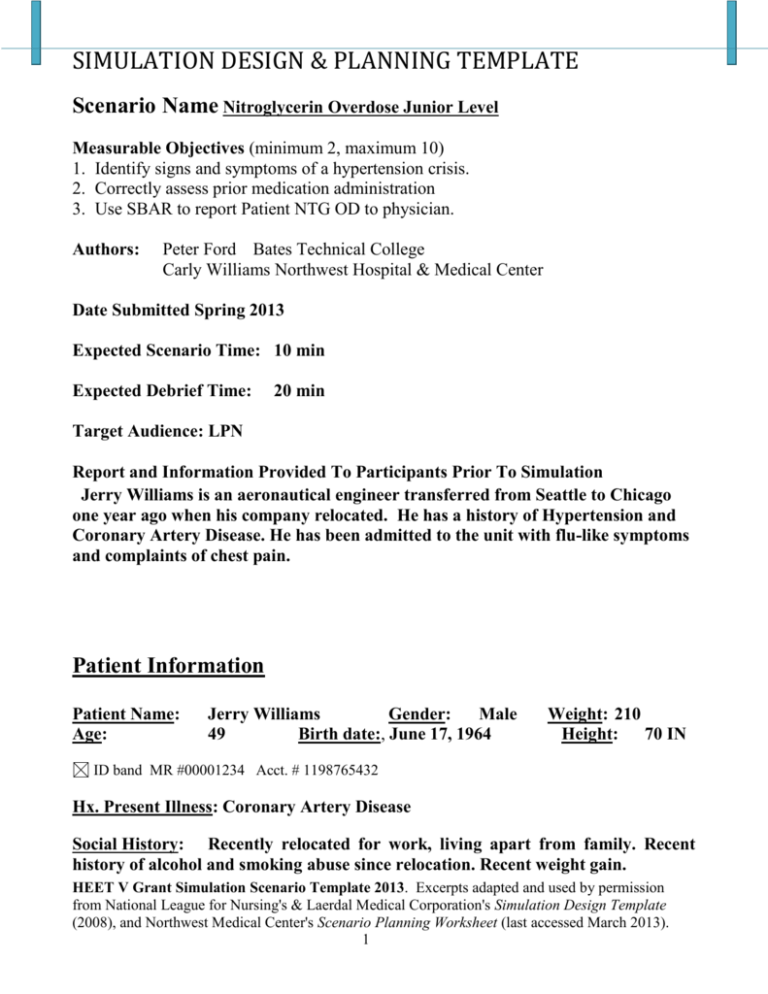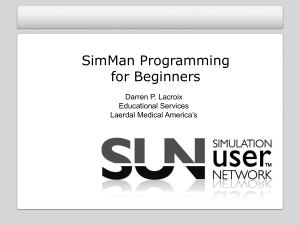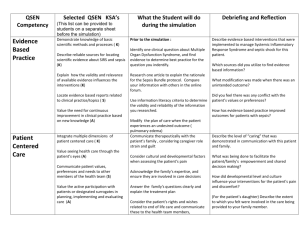Medication Overdose Junior Level
advertisement

SIMULATION DESIGN & PLANNING TEMPLATE Scenario Name Nitroglycerin Overdose Junior Level Measurable Objectives (minimum 2, maximum 10) 1. Identify signs and symptoms of a hypertension crisis. 2. Correctly assess prior medication administration 3. Use SBAR to report Patient NTG OD to physician. Authors: Peter Ford Bates Technical College Carly Williams Northwest Hospital & Medical Center Date Submitted Spring 2013 Expected Scenario Time: 10 min Expected Debrief Time: 20 min Target Audience: LPN Report and Information Provided To Participants Prior To Simulation Jerry Williams is an aeronautical engineer transferred from Seattle to Chicago one year ago when his company relocated. He has a history of Hypertension and Coronary Artery Disease. He has been admitted to the unit with flu-like symptoms and complaints of chest pain. Patient Information Patient Name: Age: Jerry Williams Gender: Male 49 Birth date:, June 17, 1964 Weight: 210 Height: 70 IN ID band MR #00001234 Acct. # 1198765432 Hx. Present Illness: Coronary Artery Disease Social History: Recently relocated for work, living apart from family. Recent history of alcohol and smoking abuse since relocation. Recent weight gain. HEET V Grant Simulation Scenario Template 2013. Excerpts adapted and used by permission from National League for Nursing's & Laerdal Medical Corporation's Simulation Design Template (2008), and Northwest Medical Center's Scenario Planning Worksheet (last accessed March 2013). 1 SIMULATION DESIGN & PLANNING TEMPLATE Religion: Agnostic Support System: Family lives out of state. Allergies: Morphine Attending Physician: Sylvia Oberholtzer Past medical history: Hypertension (HTN). Coronary Artery Disease (CAD), Complaints of chest pain. Developed edema approximately 2 weeks before admission. Physical description of how you want the manikin to present at start of scenario? Moulage: Add picture here: Patient or Family member holding bottle of NTG from home. Peripheral Edema - legs (third party leggings/label stating edema - pictures below) Assignment Of Roles (Please indicate below roles to be assigned): Primary Nurse Secondary Nurse Family Member #1 Observer(s) Important Information Related To Roles: Family Member - overly protective and worried for patient's safety. Increasingly if NTG is given by Nurse. HEET V Grant Simulation Scenario Template 2013. Excerpts adapted and used by permission from National League for Nursing's & Laerdal Medical Corporation's Simulation Design Template (2008), and Northwest Medical Center's Scenario Planning Worksheet (last accessed March 2013). 2 SIMULATION DESIGN & PLANNING TEMPLATE Fidelity (choose all that apply to this simulation) Setting/Environment Med-Surg Medications and Fluids: Oral Meds: Lisinopril, HCTZ, NTG Props: Equipment attached to manikin: Monitor attached/ Type ID band Documentation Forms: Admit Orders Physician Orders MAR Equipment available in room: Recommended Mode for Simulation Manual/Programmed Hybrid Crash cart c airway devices and emergency meds Other: Saline Lock O2 Nasal Cannula Manikin to be used: SimMan3G Physician Orders PRN - NTG 0.4 SL tablet x3 HEET V Grant Simulation Scenario Template 2013. Excerpts adapted and used by permission from National League for Nursing's & Laerdal Medical Corporation's Simulation Design Template (2008), and Northwest Medical Center's Scenario Planning Worksheet (last accessed March 2013). 3 SIMULATION DESIGN & PLANNING TEMPLATE Scenario Progression Outline Stage 1 Initial Amount Time in Initial Stage- 5 mins Baseline Vital Signs T PR 99-90-22 BP 150/92 SPO296 Cardiac Rhythm Sinus Breath Sounds Crackles Heart Sounds Normal Abdominal Sounds Active Other Symptoms: Eyes open, half closed, or closed Trending: VS ↑ or↓ over time BP Trending down Verbalization (Pt/Manikin Cues) Dont feel well - slight headache -I feel like I should have to urinate but haven’t since the middle of the night -I’m SOB -Complain of chest pain, radiating pressure Expected Interventions -Assess chest pain -Identify prior medication ingestion -Elevate head of bed -Administer O2 2L/hr via nasal cannula Correct Treatment Choice: Identifies that patient has taken NTG Stage 2 Timing Sequence Expected 4:00 Interventions Baseline Vital Signs Monitor patient T 99 and identify P 84 stabilization of R 22 vital signs and BP 134/82 level of pain. SPO295 Cardiac Rhythm Sinus Breath Sounds Crackles Heart Sounds Normal Abdominal Sounds Active Other Symptoms: Alternate or Incorrect Treatment Choice That Will Affect Outcome Admin of NTG tablets causing patient vitals to crash and possibly lose consciousness Confederate Actions/Additional Role Player Cues As the nurse is making an assessment the family member states, "I just gave 2-3 NTG tablets right before the nurse entered the room." Alternate or Incorrect Treatment choice: Gives additional NTG Stage 2A Timing Sequence Expected 1:00 Interventions Baseline Vital Signs T 99 P 105 R 27 BP 105/54 SPO287(if no O2 given) Cardiac Rhythm Sinus>Vent Tachy Breath Sounds Crackles Heart Sounds Normal Tachy Call for Help Abdominal Sounds Active Other Symptoms: Verbalization Verbalization HEET V Grant Simulation Scenario Template 2013. Excerpts adapted and used by permission from National League for Nursing's & Laerdal Medical Corporation's Simulation Design Template (2008), and Northwest Medical Center's Scenario Planning Worksheet (last accessed March 2013). 4 SIMULATION DESIGN & PLANNING TEMPLATE Instructor Check List (return to CHESC assistant at the end of class) Pre-Scenario Check List 1. 2. 3. 4. 5. 6. 7. 8. Equipment is staged as requested. The learner has been oriented to the simulator. The learner understands the guidelines/expectations for the scenario. Participants understand their assigned roles. The time frame Expectations for simulation met: Yes No. The time frame Expectations for debrief met: Yes No. Audio/Visual Consent signed and turned into CHESC sheet. Attendance sheet completed and given to CHESC staff. Post Scenario If you could change anything next time, what would it be? Comments: ________________________________________________________ ________________________________________________________ ________________________________________________________ CHESC Assistant Name: Did the person provide excellent support for the scenario? Yes No Comment Instructor signature ________________________________ Date ________________________ HEET V Grant Simulation Scenario Template 2013. Excerpts adapted and used by permission from National League for Nursing's & Laerdal Medical Corporation's Simulation Design Template (2008), and Northwest Medical Center's Scenario Planning Worksheet (last accessed March 2013). 5 SIMULATION DESIGN & PLANNING TEMPLATE Participant Check List (return to Instructor at the end of class) Pre-Scenario Check List 1. 2. 3. 4. 5. I have been oriented to the simulator. I understand the guidelines/expectations for the scenario. I understand the assigned role. My questions about the simulation have been answered. I have all necessary equipment for the simulation. Post Scenario If you could change anything next time, what would it be? Comments: ________________________________________________________ ________________________________________________________ ________________________________________________________ ________________________________________________________ Participant Signature ____________________________________ Date ________________________ HEET V Grant Simulation Scenario Template 2013. Excerpts adapted and used by permission from National League for Nursing's & Laerdal Medical Corporation's Simulation Design Template (2008), and Northwest Medical Center's Scenario Planning Worksheet (last accessed March 2013). 6 SIMULATION DESIGN & PLANNING TEMPLATE Simulation Post-Assessment Methods Checklist Tests Evaluations Turning Point Jeopardy Other Optional Literature References Debriefing Guidelines (Remember to identify important concepts or curricular threads that are specific to your program) 1. Leave the simulation room and go to a conference room, if possible. It allows for deescalation of emotions. 2. Solicit and validate emotions briefly. Validate simisms (the simulation isn’t 100% accurate due to different equipment, personnel etc) 3. What went WELL in this simulation? 4. What DID NOT go well in this simulation? 5. If you could do it again, what would you do differently? 6. Summarize: “What I hear you saying is . . .” HEET V Grant Simulation Scenario Template 2013. Excerpts adapted and used by permission from National League for Nursing's & Laerdal Medical Corporation's Simulation Design Template (2008), and Northwest Medical Center's Scenario Planning Worksheet (last accessed March 2013). 7 SIMULATION DESIGN & PLANNING TEMPLATE Resources: www.micromedexsolutions.com http://www.ncbi.nlm.nih.gov/pubmed/23247304 Medication Administration Record Scheduled Medications Diagnosis Drug, Dose, Route, Frequency Room/Bed# 2400-0659 0700-1459 1500-2359 HEET V Grant Simulation Scenario Template 2013. Excerpts adapted and used by permission from National League for Nursing's & Laerdal Medical Corporation's Simulation Design Template (2008), and Northwest Medical Center's Scenario Planning Worksheet (last accessed March 2013). 8 SIMULATION DESIGN & PLANNING TEMPLATE Printed name Initials Printed Name Initials Printed Name Initials Printed Name Initials Printed Name Initials Printed Name Initials Affix Patient Label Medication Administration Record HEET V Grant Simulation Scenario Template 2013. Excerpts adapted and used by permission from National League for Nursing's & Laerdal Medical Corporation's Simulation Design Template (2008), and Northwest Medical Center's Scenario Planning Worksheet (last accessed March 2013). 9





